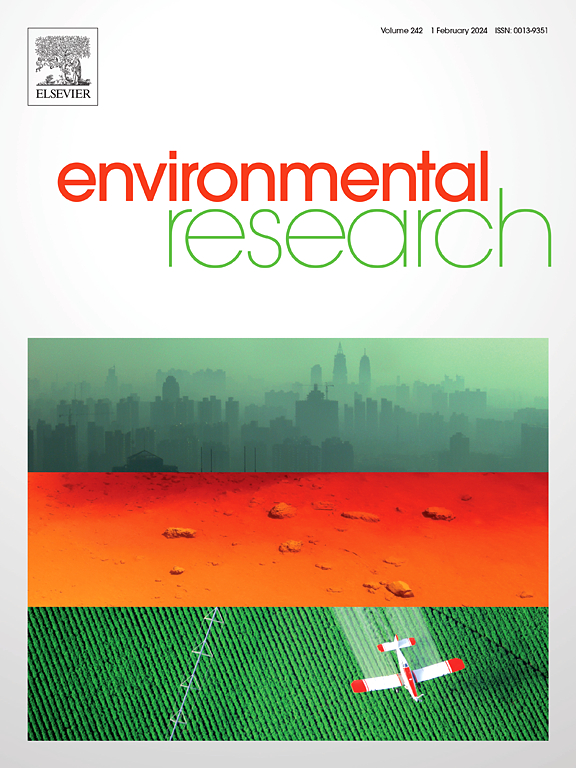Contamination and risk assessment of Thallium in the alluvial paddy rice soil system of Pakistan
IF 7.7
2区 环境科学与生态学
Q1 ENVIRONMENTAL SCIENCES
引用次数: 0
Abstract
Thallium (Tl) is considered a highly toxic trace metal. This study not only examines Tl contamination in paddy soil and its accumulation in rice tissues within the Alluvial Indus Basin of Pakistan, but also evaluates its potential risk associated with the food chain. Tl concentrations in paddy soil ranged from 0.01 to 5.89 mg/kg, averaging 0.89 mg/kg, which exceeded the typical background level of 0.58 mg/kg in Chinese soils. Tl levels in rice grains ranged from 0.11 to 1.78 mg/kg, averaging 0.33 mg/kg, with 15.5 % of samples exceeding the Food Safety and Standards Authority of India's (FSSAI) limit of 0.2 mg/kg, confirming Tl accumulation and raising health concerns. Geographically weighted regression (GWR) modelling revealed spatially varying correlations between rice Tl and soil (pH, SOM, TOC, TIC, TC, and Tl) and plant tissue (shoot and root Tl) variables, with differential impacts on Tl accumulation. The GWR model determined the Critical Tl Threshold (CTT) for Tl concentrations in paddy soil, confirming significant Tl risk in areas exceeding the CTT. The GWR model also assessed Tl Loading Capacity (TLC), defined as the difference between the CTT and the actual Tl concentration in paddy soil. This analysis identified areas at risk for Tl contamination in rice, classified as low-risk (10 %), high-risk (59.2 %), and very high-risk (30.8 %). The study highlights that children face a significantly higher health risk from Tl exposure, with a Hazard Index (HI) of 29.6 %, exceeding the safety threshold. In comparison, adults and lifetime exposure have lower HI values of 19.6 % and 19 %, respectively. These findings underscore the need for effective soil management strategies to mitigate Tl contamination and associated health risks.

巴基斯坦冲积水稻土系统中铊的污染及风险评价
铊被认为是一种剧毒的微量金属。本研究不仅考察了巴基斯坦冲积印度河流域水稻土壤中的Tl污染及其在水稻组织中的积累,而且还评估了其与食物链相关的潜在风险。水稻土中Tl浓度范围为0.01 ~ 5.89 mg/kg,平均值为0.89 mg/kg,超过了中国土壤典型背景水平0.58 mg/kg。稻米中硫的含量从0.11至1.78毫克/公斤不等,平均为0.33毫克/公斤,15.5%的样品超过了印度食品安全和标准局(FSSAI) 0.2毫克/公斤的限制,证实了硫的积累,并引起了健康问题。地理加权回归(GWR)模型揭示了水稻Tl与土壤(pH、SOM、TOC、TIC、TC和Tl)和植物组织(茎和根)变量之间的空间相关性,对Tl积累的影响存在差异。GWR模型确定了水稻土中Tl浓度的临界Tl阈值(CTT),确认了超过CTT的地区存在显著的Tl风险。GWR模型还评估了Tl负荷能力(TLC), TLC定义为水稻土中CTT与实际Tl浓度之间的差值。该分析确定了水稻中Tl污染的风险区域,分为低风险(10%)、高风险(59.2%)和非常高风险(30.8%)。该研究强调,儿童暴露于辐射辐射后面临的健康风险明显更高,危害指数(HI)为29.6%,超过了安全阈值。相比之下,成人和终生接触的HI值分别较低,为19.6%和19%。这些发现强调需要有效的土壤管理战略,以减轻土壤污染和相关的健康风险。
本文章由计算机程序翻译,如有差异,请以英文原文为准。
求助全文
约1分钟内获得全文
求助全文
来源期刊

Environmental Research
环境科学-公共卫生、环境卫生与职业卫生
CiteScore
12.60
自引率
8.40%
发文量
2480
审稿时长
4.7 months
期刊介绍:
The Environmental Research journal presents a broad range of interdisciplinary research, focused on addressing worldwide environmental concerns and featuring innovative findings. Our publication strives to explore relevant anthropogenic issues across various environmental sectors, showcasing practical applications in real-life settings.
 求助内容:
求助内容: 应助结果提醒方式:
应助结果提醒方式:


